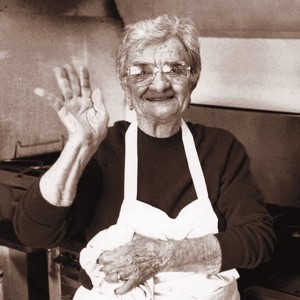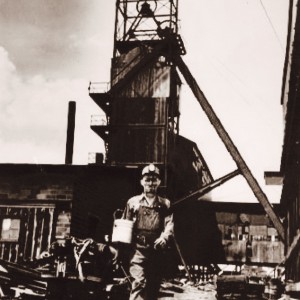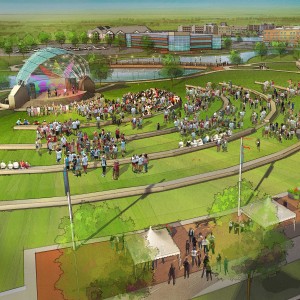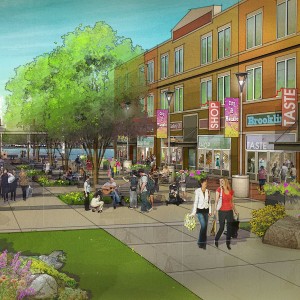One of the most well-known and respected community members from the coal mining era (and beyond) is Alice Nizzi, for whom Alice’s Road is named. Alice’s parents, Maria Santi and Bartolo Nizzi, immigrated from Italy in 1899, and then had five children. Alice was the oldest, born in 1905. Her siblings were Anita, Battista (Tom), Americo, and Remo. The family moved to Waukee to work in the Shuler mine around 1929 and lived the North Camp area. Alice married Pete Nizzi (no relation). Bartolo, Battista, Americo, and Alice’s husband Pete worked in the Shuler mine. On August 18, 1942, Americo was killed in a coal mining accident at the age of 31.

“Alice loved to cook,” said Alice’s niece Marie Kayser. “She initially worked for Rosie Vanni in her restaurant in the coal mining community and then bought her out and took over the restaurant in 1947. Five years later, she and her husband bought 40 acres of land and built a larger restaurant on the property.”
Her restaurant, Alice’s SpaghettiLand, employed many women from the coal mining community as well as many of her own family members (including Remo, Tom, and nieces and nephews) over its 50-year history.
According to Kayser, Alice and her sister Anita would alternate nights cooking at the restaurant, and they both got to know many of their customers very well. “It wasn’t unusual for either of them to be seen walking out into the dining room to talk to customers,” said Kayser.
The longstanding business and its friendly owner hold a special place in the memories and hearts of many past and present Waukee area residents. “They served and got to know multiple generations of families over the years. People who had moved away would often be sure to stop at Alice’s when they returned to the area,” said Kayser.
“She loved children, and she was a wonderful aunt to her nieces and nephews,” said her niece Mary Grace Fiori Ladurini. Sadly, all of Alice’s children died in infancy.
Alice was thrilled to be the Waukee Queen in the city’s Quasquicentennial Parade in 1994. She died in 1997 at the age of 91.
Alice’s nephew, Jim Nizzi, began managing most of the business for her in the 90’s and continued to do so until the restaurant closed in 2004. He continues to cook Alice’s food for special occasions like the Waukee Historical Society’s Annual Alice’s Night.
The Nizzi family owned other businesses in Waukee over the years as well. Remo and Battista Nizzi owned a grocery store in Waukee from 1950-1973, and Remo owned an ice cream and sandwich shop called J & M Snackland in the 1980’s. Remo was also the City Clerk/Administrator of Waukee from 1959-1979. He received the Citizen of the Year Award in 1986.
“My mom Frances worked at Alice’s up through her 80’s,” said Andreini. “She made ravioli from home, and it would be picked up and taken to the restaurant.”
Andreini also noted that Alice brought prominent people into the restaurant, such as Babe Bisignano, who owned Babe’s Restaurant in Des Moines.
“When I was about 12, I asked Alice why she opened a restaurant in a house,” said Sherri Klopf, a longtime Alice’s SpaghettiLand customer. “She told me, very smartly I thought, ‘Well, I figure if the restaurant fails, I still have a place to live.’ I thought she was the smartest woman I knew!”
Commemorating Waukee’s Coal Mining History
It was during a Shuler Mine reunion that Bruno Andreini had the idea to create a local coal mining museum. For seven years, a committee of about 10 people from the mining community met to make plans for the museum.
Andreini said that the committee had three goals –to establish a museum about the coal mining industry, to create a historical marker commemorating the Shuler Coal Mine, and to name the new school located near the old coal mine Shuler Elementary. All three goals have been accomplished.
Hiram Ori, son of former Shuler Coal Mine worker Ernest Ori, left a bequest of $500,000+ to the Waukee Public Library to build a coal mine museum that would preserve this piece of Waukee’s history. The museum, located within the library, opened in November 2013 and features coal mine tools, artifacts and touch screen videos.

A massive 13-foot-tall sculpture at the intersection of Douglas and Berkshire Parkways also honors the area’s coal mining history. It features a piece of coal, or “black diamond,” supported by four steel beams. At the base are four different vignettes that pay homage to the Shuler Coal Company, its miners and their families that resided at the mining camps between 1921 and 1949.
The sculpture was created by artists Rebecca Ekstrand and Thomas Rosoborough at a cost of about $45,000. It was paid for by a grant from the Iowa Department of Cultural Affairs, as well as contributions from the cities of Waukee and Clive, the Dallas County Foundation, Bravo of Greater Des Moines and private donations.
In addition, Shuler Elementary, which opened in 2010, is named in honor of The Shuler Coal Company, once a major employer and economic player in Waukee. It sits only 1,500 feet from where the company was once located.
Looking Ahead: The Kettlestone Vision
Plans for a major expansion have been in the planning stage for the past 20 years, as the City of Waukee worked to obtain federal funding and approval for the new interchange along Interstate Highway 80 between Waukee and West Des Moines that will open next year.
City officials say it’s critical for Waukee to capitalize on the 1,500 acres of undeveloped land that could become a regional destination after the new interchange opens.
The area was originally referred to as Alice’s Road Corridor, until the City of Waukee and the City of West Des Moines decided to work together to establish a name that would bring the communities together. The City of West Des Moines wanted a name that represented technology, while the City of Waukee preferred a name that was based on the area’s geology. In the end, they settled on the name Kettlestone, which was inspired by the small lakes, or kettle ponds, left behind by the glaciers that once covered the region.

The Kettlestone development, a community-within-a-community, will be built between Hickman Road and I-80. Featuring an outdoor town center in a walkable environment, Kettlestone will include 7,000 new housing units, 3.8 million square feet of commercial retail space and 5.5 million square feet of commercial office space. It is estimated to increase the Waukee population by 17,500, and holds the potential for 25,000 new jobs.
“First, the infrastructure needs to be in place, which includes building the roadway, sewer, water lines, storm water, and parks,” said Tim Moerman, City Manager. “There is a comprehensive plan for transportation, and mixed-use land for residential and businesses. Kettlestone has been driven by the roadway project from University Avenue to the interchange and includes 1,500 acres.”
Moerman explained that there are two major steps to the roadway project. “The first step is to create the road now named Grand Prairie Parkway starting at University Avenue to Ashworth Road, and the second step is to continue Grand Prairie Parkway from Ashworth Road to the interchange. Waukee is paying $35 million for the infrastructure costs, and is sharing the cost of the interchange with West Des Moines.” The financial breakdown will also receive $9 million from West Des Moines for the shared interchange, $11 million from federal money, and $5 million from the State of Iowa money.
“In the future,” Moerman said, “West Des Moines will have the additional cost and responsibility for putting in an additional road from the interchange to Grand Avenue. “
Moerman has been working with 10 city staff members and Confluence, a professional consulting firm. They are currently working on master planning at the district level. (Districts are sections of the project throughout Kettlestone.) They are also planning three bicycle underpasses and eight new miles of trails that connect to the current trail systems.

“No commitments have been made, and no land has been purchased by businesses to go in Kettlestone yet, but there have been several meetings between interested businesses and Economic Development Director Dan Dutcher,” said Moerman.
The interchange is expected to open to traffic at the end of 2015. Off-road construction will continue on the grading, seeding and landscaping through 2016. The infrastructure is planned to be completed by the City of Waukee in September 2015.
Ground was broken on the University Avenue to Ashworth Road segment of Kettlestone on November 1, 2013. More information on Kettlestone and its progress and timelines are available at www.kettlestonewaukee.com.